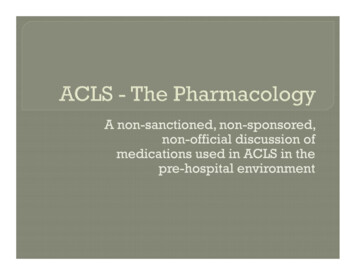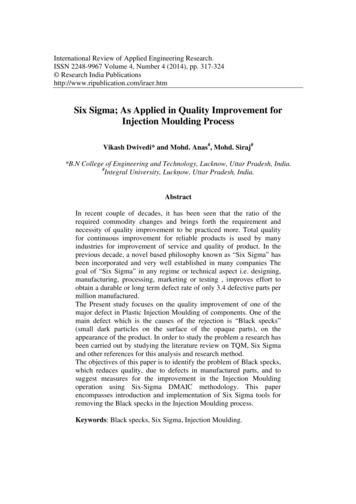
Transcription
A nonnon-sanctioned,id nonnon-sponsored,dnon--official discussion ofnonmedications used in ACLS in thepre--hospital environmentpre
Thestandardized approach of ACLS videosupplemented classes reduced the ability totailor information to the audience Studentsdealing with ACLS angst aren’t themost receptivepaudience to anythingyg else Memorizationwill get us through 16 hrs, but ithas a tendency of failing at the fairlyinopportune times
Refreshknowledge of ACLS medications Discuss reasons for changes in the lastupdated t Gain awareness of what else is ‘out there’(Agency Protocols/Practices, studies, etc.)
Do they makesense?YESYESNOIs the patienttalking?YESNOYESWe have asecond to thinkDo theynormally?Evaluate/correctpossible causesIs this new?Is there Pulse?NOEnjoy the s forchangeFind a betterhistorian
Immediaterecognition of cardiac arrestand activation of the emergencypsystemyresponse Early CPR that emphasizes chestcompressions Rapid defibrillation if indicated Effective advanced life support IntegratedI tt d post-cardiactdi arrestt careBerg RA et al. Part 5. CirculationCirculation. 2010;122(suppl2010;122(suppl 3):S685.
“The primary goal of pharmacologic therapy during cardiacarrest is to facilitate restoration and maintenance of a pperfusinggspontaneous rhythm”Neumar et al. Part 8. Circulation. 2010: S743
Epinephrine– 1 mg Repeat every 3-5 minutes Vasopressin– 40 Units May replace 1st or 2nd dose of epi Whathappened to Atropine? Sodium Bicarb?
Whatis your plan of attack? Whythe de-emphasisde emphasis of endotrachealmedications? Drug Concentration Predictability of delivery and effectNeumar et al. Part 8. CirculationCirculation. 2010: S743
Epinephrine What is it? Catecholamine Sympathomimetic Adrenergic Receptor Agonist Can you still name the receptors we are lookingto activate in arrest? (bonus for the biologiceffect they cause)
Epinephrine So when are you giving the 1 mg? Is this important?
The ‘circularcircular algorithmalgorithm’introduced toemphasizeptheimportance of CPR“There iis iinsufficient“Thffi i t evidenceidttorecommend a specific timing orsequence of drug administrationand advanced airwayy placementpduring cardiac arrest.”Neumar et al. Part 8. CirculationCirculation.2010: S737
Epinephrine So when are you giving the 1 mg? Is this important? Thehalf-life of catecholamines aremeasured are minutes (2ish)
Vasopressin What is it? A Peptide Hormone Responsible for regulating water retention bycontrollingg reabsorptionpin the tubules of thekidneys Increases PVR Causing B/P increase
Vasopressin How is it different from Epinephrine? Specificity We know how Epi affects cardiac muscle Desirable effects of increased PVR without acting onnon-specific adrenergic receptors Half life SoSwhyh jjustt considerationid tiN Sharman A & Low JJ. Vasopressinpand its role in critical care.care.
Vasopressor Anti-ArrhythmicAnti Arrhythmic Amiodarone 300 mg Second dose of 150 mgOr Lidocaine 1-1.5 mg/kg Additional dosing 0.5 – 0.75 mg/kg every 5-10 min. toa max of 3 mg/kg
Amiodarone Class III antiarrhythmic agent Prolongs phase 3 (repolarization) of the cardiacaction potential
ction-potential/
Amiodarone Class III antiarrhythmic agent Prolongs phase 3 (repolarization) of the cardiac action potentialIn Englishg– Potassium Channel BlockerAnd It has effects similar to class IaIIIV
ction-potential/
Sanghavi S & Rayner-Klein. Management of Peri-arrest Arrhythmia.
Lidocaine How does it ‘anti’ the arrhythmia? Class Ib
ction-potential/
Lidocaine How does it ‘anti’ the arrhythmia? Class IbJust Kidding!
Lidocaine How does it ‘anti’ the arrhythmia? Class Ib Na Channel Blocking So ventricular arrhythmias
l
Amiovs Lidovs. Is anyone using Lidocaine? What the Amiodarone studies say What the Lidocaine studies say Wehave our first declared winner!
Magnesium Sulfate Electrolyte Indications TdP Mechanismof Action Study Results
“Half of the patients who die of ACS do so before reaching thehospital”pO’Connor et al. Part 10. CirculationCirculation. 2010;122(suppl2010;122(suppl 3):3):S789.S789.
IsMona still greeting everyone at thedoor? She got cut back to part-timepart time Oxygen ASA Nitrates Morphine(analgesia)ANOA just isn’tisn t catchy.
Oxygen So why the change Studies! Oxygen still there for the respiratory distress,heart failure,, shock ASA Why? What if they took their own?
Nitrates Concerns? Painmanagement With? Beta-Blockers
Mistakes may be more readily evident
Returnof the term symptomatic Underlying cause identification gets anod Changes to Bradycardia Changes to Tachycardia
Atropine Anticholinergic Nonselective muscarinicacetylcholinergic antagonist So So Guerilla warfare against the Parasympathetic NS Infiltration Remove the command structure Interruption of communications
Atropine Any considerations prior to counterinsurgency? Andwhat about the ‘highhigh blocksblocks’?
Ourcommon pressors havenhaven’tt changed Epi Dopamine Solets talk ino/chrono/dromo tropes Inotrope Dromotrope Chronotrope
Whatsthe biggest change in 2010guidelines?
RichmondAmbulance Authority variesthe practice a bit From 1/1/09 – 10/31/12 Out of Hospital Cardiac Arrests: 765 (40%unwitnessed)id) ROSC at Hospital: 206 ThatThat’ss 27% of patients included Bystander CPR in 24% National ROSC without bystander CPR: 15%
AutopulseUsage 161 of the 206 with ROSC: 83% (failuresexcluded) Avg# of Epi doses per arrest – 1.6 Avgg # of Vaso doses pper arrest – 1.5
Breakdown of ROSC by initial Rhythm2%5%39%24%30%Asystole - 80PEA - 62VF - 50VT - 10Unk - 4
Autopulse Vasopressin ShortTransport Hypothermia starting in the field In 2009,2009 52% of patients with ROSC andhypothermia started in the field survived tohospital dischargeNeumar, Robert W., et al. "Implementation Strategies for Improving Survival After OutNeumar,Out-ofofHospital Cardiac Arrest in the United States Consensus Recommendations From the 2009American Heart Association Cardiac Arrest Survival Summit." Circulation 123.24 (2011): 28982898-2910.
Berg RA, Hemphill R, Abella BS, Aufderheide TP, Cave DM, Hazinski MF, Lerner EB, Rea TD, SayreMR SworMR,SRA PartRA.P 5:5 AdAdultl BBasici LifLife SSupport: 2010 AAmericaniHHeart AAssociationi i GGuidelinesid lifor Cardiopulmonary Resuscitation and Emergency Cardiovascular Care. Circulation.2010;122(suppl 3):S685-S705.Rea TD,, Helbock M,, Perryy S,, Garcia M,, Cloydy D,, Becker L,, Eisensberg,g, M. Increasingg use ofcardiopulmonary resuscitation during out-of-hospital ventricular fibrillation arrest: survivalimplications of guideline changes. Circulation. 2006; 114:2760-2765.(As cited in Circulation. 2010; 122(suppl 3): S685.)Neumar RW,RW Otto CWCW, Link MS,MS Kronick SL,SL Shuster MM, Callaway CWCW, Kudenchuk PJ,PJ Ornato JP,JPMcNally B, Silvers SM, Passman RS, White RD, Hess EP, Tang W, Davis D, Sinz E, Morrison LJ.Part 8: adult advanced cardiovascular life support: 2010 American Heart AssociationGuidelines for Cardiopulmonary Resuscitation and Emergency Cardiovascular Care.Circulation. 2010;122(suppl 3):S729-S767.N Sharman A & Low J. Vasopressin and its role in critical care. Continuing Education in Anaesthesia,Critical Care & Pain (2008) Vol. 8(Issue 4): 134-137. doi: 10.1093/bjaceaccp/mkn021Copstead Lee EllenCopstead,Ellen., and Jacquelyn L.L Banasik.Banasik Pathophysiology.Pathophysiology 3rd ed.ed 2005.2005
Harvey, Richard A., Denise R. Ferrier, and Pamela C. Champe. Lippincott's Illustrated Reviews,Biochemistry. 4th ed. 2011.L hLehne,Ri h d ARichardA. PharmacologyPhlforf NursingN i Care.C6th ed.d 2007.2007Sanghavi S & Rayner-Klein. Management of Peri-arrest Arrhythmia. British Journal of Anaesthesia:CEPD Reviews. (2002). Volume 2 (Number 4). 104-112. doi: 10.1093/bjacepd/2.4.104Hoshino, Kenji, et al. "Optimal administration dosage of magnesium sulfate for torsades de pointesin children with long QT syndrome." Journal of the American College of Nutrition 23.5 (2004):497S-500S.Neumar, Robert W., et al. "Implementation Strategies for Improving Survival After Out-of-HospitalCardiac Arrest in the United States Consensus Recommendations From the 2009 AmericanHeart Association Cardiac Arrest Survival Summit." Circulation 123.24 (2011): 2898-2910.
Autopulse Vasopressin Short Transport Hypothermia starting in the field In 2009 52% of patients with ROSC and In 2009, 52% of patients with ROSC and hypothermia started in the field survived to hospital discharge NeumarNeumar, Robert W., et al. "Implementation St, Robert W., et al. "Implementation Strarategies for Improving Survival After Outtegies for Improving Survival After Out--ofof--
